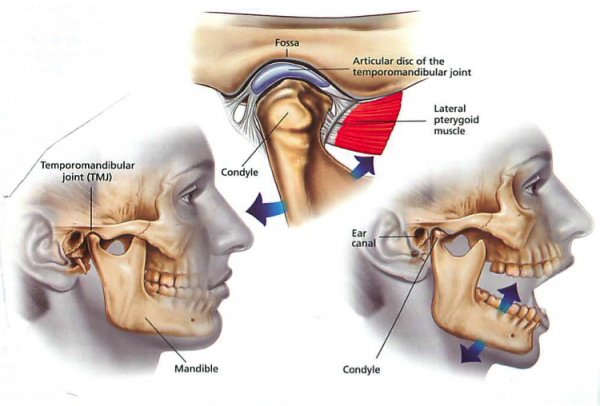TMJ stands for temporomandibular joint and refers to the two joints that connect your jaw bone or mandible, to the temporal bone of your skull. When functioning normally these joints allow you to move your jaw, chew, and speak without jaw pain or limitation. Problems with the TMJ that lead to jaw pain are called TMD (temporomandibular dysfunction). TMD can be a painful and debilitating condition and can be difficult to resolve. But with a team approach involving your Physiotherapist and an experienced Dentist patients can successfully eliminate their symptoms.
Why Does My TMJ (Jaw) Hurt?
The TMJ is a complex joint consisting of the two bones and a disc. In order to function correctly the joints on both side of your jaw must be able to open in two phases. In the first half of opening the mandible spins inside the joint. This is followed by a translational phase where the mandible and disc glide forward on the temporalis bone to achieve full opening. If this movement of the joints on each side are not coordinated it can cause misalignment of the jaw and painful symptoms.

What Are The Symptoms of TMJ?
TMD symptoms can be mild or quite severe. They can make it difficult to eat solid food. Here is a list of common symptoms that patients experience when dealing with TMJ dysfunction.
- Pain in the TMJ joint – just in front of your ear hole.
- Painful popping or clicking
- Locking of the jaw in an open position
- Muscle spasm at the angle of their jaw and on the side of their head
- Headaches
- Dizziness
Causes of TMD
Your Jaw can become injured in a variety of ways that result in painful movement, or misalignment of the jaw including;
TRAUMA – Some people sustain a trauma to the joint which results in hypermobility or after a scarring process can lead to stiffness of one of the TMJ joints. The resulting unequal movement leads to accelerated wear and tear of the joint structures.
GRINDING – Your dentist may have remarked that you are a ‘grinder’ and recommended a night guard to protect your teeth from wear. All of that grinding and clenching of the jaw while you sleep also has an effect on your TMJ joints. It can result in joint or disc injury as well as muscle spasm.
POSTURE – Most people don’t realize many of the muscles that control their jaw also attach to their upper neck. Having a “forward head posture” is a common cause of jaw dysfunction. {Photo of forward head posture}
EATING – Sometimes people injure their TMJ joints by eating. Biting large or hard objects especially if only biting on one side of the mouth can easily injure your TMJ.
Most people who seek help with their TMJ can not point to one specific incident, but rather describe a condition that came on slowly and gets worse over time.
How does Physiotherapy Eliminate TMJ Dysfunction and Pain?
IMPROVING TMJ MOBILITY – If a patient is assessed to have TMJ arising from a stiff joint (usually as a result of some past trauma that resulted in stiffness) the physiotherapist can use manual therapy techniques to get the joint moving properly again. They will then prescribe specific stretches that will help you to maintain the range of motion improvement between visits.
REDUCING MUSCLE SPASM – Physiotherapists are anatomy experts and understand how to assess the muscles of your TMJ. Often we find that muscle spasm is preventing the TMJ from recovering. Manual therapy techniques to reduce spasm will help to improve joint alignment and movement, ultimately resulting in less pain!
STRENGTHENING FOR HYPERMOBILE JOINTS – Some patients have a TMJ that moves WAY too much or in a poor pattern. Your physiotherapist can recognize this problem and help with treatments and exercises that strengthen weak muscles and improve your natural movement pattern.
POSTURAL TRAINING – Changing that forward head posture makes a big difference for some people who suffer from TMJ dysfunction. We teach patients how to strengthen postural muscles and lengthen shortened tissues so that they can improve their head position. Your Physiotherapist will also make suggestions that will help set up your workstation, car or anywhere else you spend a lot of time sitting to promote a better body position.
PAIN RELIEF FOR TMJ DYSFUNCTION – When patients are in a lot of pain and just need some relief so that they can begin to make the changes outlined above, a physiotherapist can relieve the pain with thermal modalities, acupuncture and gentle manual therapy.
A great Physiotherapist will do a thorough assessment of your particular TMJ problem and match the treatment plan to the cause of your symptoms.

0Comments